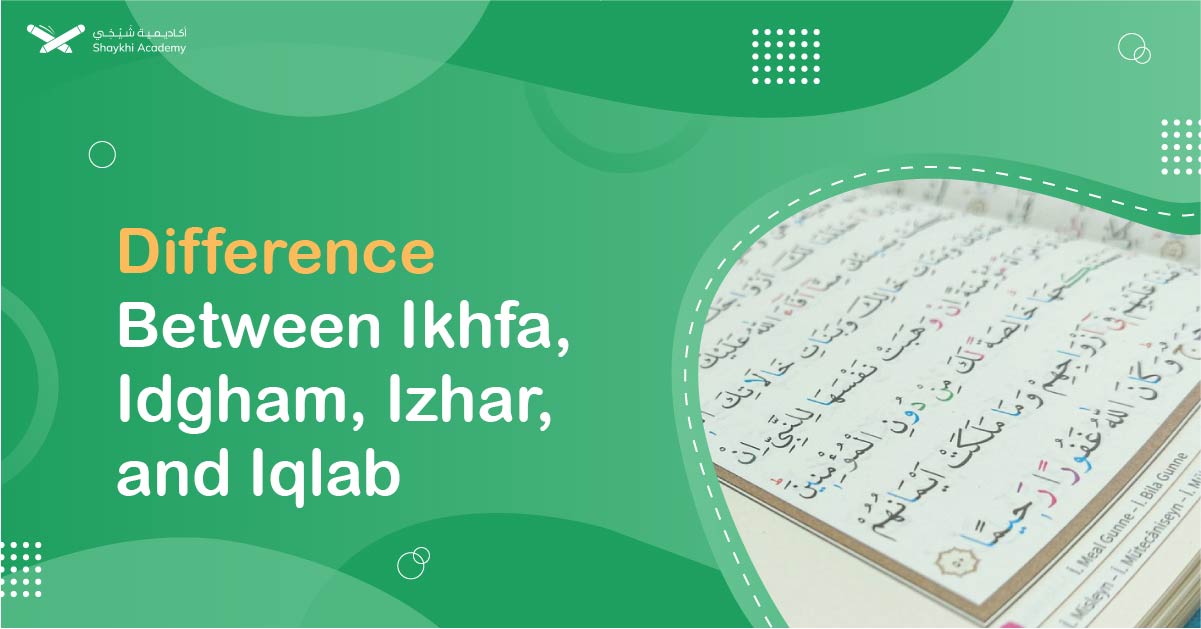Difference Between Ikhfaa, Idgham, Izhar, And Iqlab: The main difference is that Ikhfaa partially conceals with nasalization, Idgham merges letters fully with nasalization, Izhar pronounces clearly without nasalization, and Iqlab changes noon saakinah or tanween to meem with nasalization.
After learning the rules of Noon and Meem Sakinah, which are Idgham, Izhar, Ikhfa, and Iqlab, in this article we will thoroughly review each type and identify the main differences between these rules. Get ready for an enjoyable journey with Sheikh Academy in the science of Tajweed to recite the Quran with beauty and precision.
Summary of the Difference Between Ikhfaa, Idgham, Izhar, And Iqlab:
The main difference between Ikhfaa, Idgham, Izhar, and Iqlab is their effect on the pronunciation of noon saakinah or tanween: Ikhfaa involves partial concealment with nasalization when followed by specific letters, Idgham entails complete merging into the next letter, creating a single stressed letter with nasalization, Izhar requires clear articulation without nasalization when followed by throat letters, and Iqlab changes the noon saakinah or tanween into a meem with nasalization when followed by the letter “ba.
| Concept | Definition | Letters | Examples from Quran |
| Idgham | Merging one letter into another to form a single stressed letter with nasalization (ghunnah). Occurs when a letter (sakin) meets a vowel letter (mutaharik). | ي (Ya), ر (Ra), م (Meem), ل (Lam), و (Waw), ن (Noon). Complete (Kamil) with ر، م، ل، ن and incomplete (Naqis) with ي، و | – مِن وَلِي (Al-Baqarah 107)<br>- فَمَن يَـعْمَلْ (Az-Zalzalah 7)<br>- مِن نَّـفْعِهِمَا (Al-Baqarah 219) |
| Izhar | Clear pronunciation of noon (ن) or tanween without nasalization (ghunnah). The noon and tanween are articulated clearly without merging or changing. | ء (Hamza), هـ (Haa), ع (Ain), ح (Haa), غ (Ghayn), خ (Khaa) | – مَنْ ءامَنَ (At-Tawba 18)<br>- مِنْ عِلْمٍ (An-Najm 28)<br>- مِنْ خَيْرٍ (Al-Qasas 24) |
| Iqlab | Transforming noon saakinah (ن) or tanween into a meem (م) with nasalization (ghunnah) when followed by the letter “ba” (ب). | ب (Ba) | – أَنبِئُونِي (Al-Baqarah 31)<br>- مِنْ بَعْدِهِمْ (Al Muminoon 31)<br>- لَنَسْفَعًا بِالنَّاصِيَةِ (Al-‘Alaq 15) |
| Ikhfaa | A state between Izhar and Idgham where the noon is not fully articulated nor completely merged. It is pronounced with a nasal sound (ghunnah) and without stressing the letter. | ص (Saad), ذ (Dhaal), ث (Thaa), ج (Jeem), ش (Sheen), ق (Qaaf), س (Seen), د (Daal), ط (Taa), ز (Zaay), ف (Faa), ت (Ta), ض (Daad), ظ (Dhaa) | – يَنْصُرُونَ (yansuroon)<br>- مَنْ صَلْصَالٍ (min ṣalsāl)<br>- ريحاً صَرْراً (rihan sararan)<br>- أأنذرتهم (a’anthartahum)<br>- من ذا الذي (man dhā al-ladhī) |
Let’s discuss them in detail below:
Definition of Idgham:
Idgham is the merging of one letter into another.it happens when meeting a letter (saken) with a vowel letter (mutaharek) such that they become a single stressed (shaddah) letter, with the tongue rising once when pronouncing them, equivalent to the weight of two letters.
Idgham letters:
ي (Ya),ر (Ra), م ( Meem),ل ( Lam), و ( Waw), ن ( Noon).
If one of these six letters (Ya, Ra, Meem, Lam, Waw, Noon) occurs after a Noon Sakinah, with the condition that the Noon is at the end of a word and one of these letters is at the beginning of the next word, or after Tanween (which only occurs between two words), Idgham is the rule.
Then, Idgham is incomplete (Naqis) with ي( Ya) and و ( Waw), and complete (Kamil) with the rest of the letters in (Ra ر -Meem م -Lam ن – ل Noon).
Examples of Idgham from holy Quran:
| Letters | Example | Explanation | Surah | Ayah |
| و (waw), ن (Noon), | مِن وَلِي | “ن” merges into “و” with a nasal sound. | Al-Baqarah | 107 |
| ٍ(tanween) , و (Waw) | وَلِيٍّ وَلاَ | “Tanween” merges into “و” with a nasal sound. | Al-Baqarah | 107 |
| ي (ya) , ن (noon) | فَمَن يَـعْمَلْ | “ن” merges into “ي” with a nasal sound. | Az-Zalzalah | 7 |
| ً (tanween) , ي (Ya) | خَيْراً يَرَهُ | “tanween” merges into “ي” with a nasal sound. | Az-Zalzalah | 7 |
| ن (Noon), ن (Noon), | مِن نَّـفْعِهِمَا | Mergeing two “ن” into one “ن” with a nasal sound. | Al-Baqarah | 219 |
| م (Meem) , ن (Noon) | مِن مَّـاء | “ن” merges into “م” with a nasal sound. | Ibrahim | 16 |
| ً (Tanween) , م (Meem) | وَلَيَكُونـاً مِّنَ | “Tanween” merges into “م” with a nasal sound. | Yusuf | 32 |
| ً (tanween) , ن (Noon) | يَوْمَئِذٍ نَّـاعِمَةٌ | “tanween” merges into “ن” with a nasal sound. | Al-Ghashiya | 8 |
What is Izhar?
Al-Izhar (Clear Articulation) is the pronunciation of the noon (ن) clearly from its place of articulation without nasalization (ghunnah). Izhar means that the noon saakinah or the tanween is pronounced clearly without complete nasalization, and then the izhar letter is pronounced without any pause or break between them.
The reason for the clear pronunciation of the noon and the tanween before the six izhar letters is the separation between the articulation point of the noon and the tanween, and the articulation point of these letters. The noon and the tanween are articulated from the tip of the tongue, while the six letters are articulated from the throat, creating a clear distance between their articulation points.
Letters of Izhar:
Izhar letters are six: (ء, هـ, ع, ح, غ, خ), which are called the throat letters (letters of the throat). When any of these six letters comes after the noon, whether within the same word or in two separate words (where the noon is at the end of the first word and the izhar letter is at the beginning of the second word), and when these letters come after the tanween, it is obligatory to pronounce the noon and the tanween clearly. This is called Izhar Halqi (Throat Izhar) because its six letters originate from the throat.
Examples of Izhar from the holy Quran:
| Letters | Example | Explanation | Surah | Ayah |
| ن (Noon), ء (Hamza), | مَنْ ءامَنَ | The noon (ن) is pronounced clearly without nasalization (ghunnah), and the hamza (ء) is pronounced clearly | At-Tawba | 18 |
| أ (Hamza) , ن (Noon) | وَيَنْأَوْنَ | The noon (ن) is pronounced clearly without nasalization (ghunnah), and the hamza (ء) is pronounced clearly | Al-An’aam | 26 |
| ه(Haa) , ن (Noon) | مِنْ هَادٍ | The noon (ن) is pronounced clearly without nasalization (ghunnah), and the haa (ه) is pronounced clearly | Az-Zumar | 36 |
| ه (Haa) , ن (Noon) | يَنْهَوْنَ | The noon (ن) is pronounced clearly without nasalization (ghunnah), and the haa (ه) is pronounced clearly | Al-An’aam | 26 |
| ع (Ain) , ن (Noon) | مِنْ عِلْمٍ | The noon (ن) is pronounced clearly without nasalization (ghunnah), and the Ain (ع) is pronounced clearly | An-Najm | 28 |
| ع (Ain) , ن (Noon) | وَالأَنْعَامُ | The noon (ن) is pronounced clearly without nasalization (ghunnah), and the Ain (ع) is pronounced clearly | An-Nahl | 5 |
| ح (ḥā’) , ن (Noon) | مِنْ حَكِيمٍ | The noon (ن) is pronounced clearly without nasalization (ghunnah), and the ḥā’ (ح) is pronounced clearly | Fussilat | 42 |
| ح (ḥā’) , ن (Noon) | يَنْحِتُونَ | The noon (ن) is pronounced clearly without nasalization (ghunnah), and the ḥā’ (ح) is pronounced clearly | Al-Hijr | 82 |
| غ (ghayn ) , ن (Noon) | مِنْ غِلٍّ | The noon (ن) is pronounced clearly without nasalization (ghunnah), and the ghayn (غ) is pronounced clearly | Al-Hijr | 47 |
| غ (ghayn ) , ن (Noon) | فَسَيُنْغِضُونَ | The noon (ن) is pronounced clearly without nasalization (ghunnah), and the ghayn (غ) is pronounced clearly | Al-Israa | 51 |
| خ ( khā’) , ن (Noon) | مِنْ خَيْرٍ | The noon (ن) is pronounced clearly without nasalization (ghunnah), and the خ ( khā’) is pronounced clearly | Al-Qasas | 24 |
| خ ( khā’) , ن (Noon) | وَالْمُنْخَنِقَةُ | The noon (ن) is pronounced clearly without nasalization (ghunnah), and the خ ( khā’) is pronounced clearly | Al-Maaida | 3 |
To learn more about Al-Izhar, enroll in the Tajweed lessons offered by Sheikh Academy. These simplified and easy lessons teach you Tajweed step by step, making your Quran recitation more beautiful
Al-Iqlab Definition:
Al-Qalb (إقلاب – Substitution): In technical terms, it means replacing one letter with another while considering nasalization (ghunnah) and concealment (ikhfa) in the substituted letter. Here, it specifically refers to the transformation of a noon saakinah (ن) or tanween (ً/ٍ/ٌ) into a meem (م). There is one letter associated with this rule, which is the letter “ba” (ب).
If a “ba” follows a noon saakinah, whether in the same word, in two separate words, after tanween, or after the light noon of emphasis (ن) connected to the present tense verb resembling tanween, the noon saakinah, tanween, and the noon of emphasis must be changed into a pure meem.
Examples of Al-Iqlab from the holy Quran:
In the verse: “( أَنبِئُونِي )”[Al-Baqarah : 31] , the noon is changed to a meem. Also, in the verse: “( مِنْ بَعْدِهِمْ )” [Al Muminoon : 31] , the noon saakinah is changed to a meem and pronounced with nasalization (ghunnah). Additionally, in the verse: “( وَاللَّهُ عَلِيمٌ بِذَاتِ الصُّدُورِ)” [Al Taghabun : 4] , and in His saying: “( لَنَسْفَعًا بِالنَّاصِيَةِ)” [Al-‘Alaq: 15], the noon of emphasis is pronounced as a meem with nasalization (ghunnah).
It is clear from the definition of Iqlab that it is realized through three aspects:
- Changing the noon saakinah or tanween into a meem.
- Concealing this meem in the presence of the letter ba (ب) .
- Applying nasalization (ghunnah) with this concealment.
To learn more about Al-iqlab, enroll in the Tajweed lessons offered by Sheikh Academy. These simplified and easy lessons teach you Tajweed step by step, making your Quran recitation more beautiful.
Al-Ikhfaa Definition
The other rule for the noon saakinah and tanween is Ikhfa. Ikhfa is a state between Izhar (clear pronunciation) and Idgham (merging), where the pronunciation of the noon is neither fully articulated like in Izhar, nor completely merged like in Idgham, which requires assimilation between the merged letter and the merging letter.
The letters of Ikhfaa:
There are fifteen Ikhfa letters: (ص، ذ، ث، ج، ش، ق، س، د، ط، ز، ف، ت، ض، ظ). When one of these letters follows a noon saakinah or tanween, the rule of Ikhfa is applied by pronouncing the noon saakinah or tanween in a manner that is between Izhar and Idgham, along with nasalization (ghunnah) for two counts without stressing the letter. Ikhfa for the noon saakinah can occur within one word or across two words, while Ikhfa for tanween occurs only across two words.
How to realize Ikhfaa?
Ikhfa is realized through three aspects, as evident from its definition:
- Pronouncing the noon saakinah or tanween in real Ikhfa—or the meem saakinah in oral Ikhfa—in a manner between Izhar and Idgham.
- Not stressing the concealed letter, unlike in Idgham.
- Applying nasalization (ghunnah) matching the letter that follows, so that the nasal sound blends with the following letter.
The reason for Ikhfa with these letters is that they are neither as close to the noon and tanween as the Idgham letters, which necessitates merging, nor as distant as the Izhar letters, which necessitates clear pronunciation. Thus, Ikhfa is a middle state between Idgham and Izhar, where the actual noon or tanween sound is removed but its characteristic nasalization (ghunnah) remains. Oral Ikhfa occurs due to the similarity between the letters meem and ba, making pronunciation easier.
Examples of Al-Ikhfaa from holy Quran:
| Letter | With ن (Noon) sakinah in one word | With ن (Noon) sakinah in two words | After tanween |
| ص (Saad) | yansuroon (ينصرون) | min ṣalsāl (من صلصال) | (rihan sararan) ريحاً صررا |
| ذ (Dhaal) | a’anthartahum (أأنذرتهم) | man dhā al-ladhī (من ذا الذي) | (sira’an thalik) سراعاً ذلك |
| ث (Thaa) | manthooran (منثورا) | min thamaratihi (من ثمره) | (tamhidan thumma) تمهيداً ثم |
| كـ (Kaaf) | minkum (منكم) | man kāna (من كان) | (rizqon karim) رزقٌ كريم |
| ج (Jeem) | nunajji (ننجي) | man jā’a (من جاء) | (fasabrun jamil) فصبرٌ جميل |
| ش (Sheen) | insha’a (إنشاء) | man shā’a (من شاء) | (‘ilm shay’in) علمٍ شيئًا |
| ق (Qaaf) | yanqodoon (ينقضون) | min qabli (من قبل) | (thamanan qalilan) ثمناً قليلا |
| س (Seen) | minsa’atahu (منسأته) | min su’ (من سوء) | (‘abidatan sa’ihat) عابدتٍ سائحات |
| د (Daal) | andadan (أندادا) | min dābbah (من دابة) | (qunwanin daniyah) قنوانٍ دانية |
| ط (Taa) | halalant tayyiban (حلالاً طيبا) | min ṭayyibāt (من طيبات) | (halalan tayyiban) حلالاً طيبا |
| ز (Zaay) | yanzi’ (ينزع) | fa’in zallaltum (فإن زللتم) | (yawma’idhin zurqa) يومئذٍ زرقا |
| ف (Faa) | al-anfaal (الأنفال) | wa’in fātakum (وإن فاتكم) | (su’an fasiqin) سوءٍ فاسقين |
| ت (Ta) | antum (أنتم) | man tāba (من تاب) | (jannatin tajri) جناتٍ تجري |
| ض (Daad) | mandood (منضود) | man ḍalla (من ضل) | (masjidan diraran) مسجداً ضرارا |
| ظ (Thaa) | yanzuroon (ينظرون) | man ẓalam (من ظلم) | (qawmun thalamu) قومٌ ظلموا |
Learn Tajweed with Sheikh Academy
At Sheikh Academy, we offer comprehensive Tajweed courses designed for all levels of learners, from beginners to advanced students. Our courses are meticulously structured to ensure that you grasp the essential rules and techniques of Tajweed, enabling you to recite the Quran with accuracy and beauty.
With experienced instructors and a supportive learning environment, Sheikh Academy provides personalized feedback and guidance to help you master the art of Quranic recitation. Join us at Sheikh Academy and take your Quran recitation to the next level, deepening your connection with the holy text and enhancing your spiritual journey.
Why Choose Shaykhi Academy?
- Connect with highly qualified native tutors.
- Flexible scheduling to suit your busy lifestyle.
- Affordable classes tailored for all levels.
- Accessible from anywhere around the globe.
Discover Our Range of Courses:
- Arabic Noorani Qaida: Lay a solid foundation for Quranic studies.
- Online Quran Classes for Kids: Engaging lessons for lifelong learning.
- Tajweed Rules for Kids: Learn to recite with confidence.
- Quran Hifz for Kids: Step-by-step guidance to memorize the Quran.
- Quran for Adults: Introduce yourself to Quran reading and Tajweed rules.
- Online Arabic Courses: Master the language of the Quran.
- Islamic Studies: A wide range of topics related to Islam, including theology, law, Quranic studies, Hadith.
Don’t Miss Out on Your Chance to Excel!
Whether you’re a beginner or seeking advanced knowledge, Shaykhi Academy can guide you! Book your free trial now and make Ramadan 2024 your Quranic turning point!
Conclusion:
In conclusion, we hope that you have enjoyed and learned a lot from this journey into the science of Tajweed, specifically the rules of the static Noon and Meem which include Idgham, Izh-har, Ikhfa, and Iqlab.
Understanding and applying these rules enhances the beauty and precision of Quranic recitation, allowing the reader to connect more deeply with the spirit of the Quranic text, fostering reverence and contemplation.
We wish you success in applying these rules during your recitation and encourage you to continue learning and developing your Tajweed skills through the lessons available at Sheikhy Academy.
We pray that Allah makes us and you among those who recite the Quran with true dedication, reflect upon its meanings, and gathers us in the highest levels of Paradise with the prophets and the righteous.

































